rims AUDI A4 AVANT 2008 Owners Manual
[x] Cancel search | Manufacturer: AUDI, Model Year: 2008, Model line: A4 AVANT, Model: AUDI A4 AVANT 2008Pages: 368, PDF Size: 46.19 MB
Page 124 of 368
![AUDI A4 AVANT 2008 Owners Manual -
Seats and storage
----=---------------
0 Note
To avoid damaging the socket, only use plugs that fit properly.
[ i] Tips
When the engine is off and accessories are still plugg AUDI A4 AVANT 2008 Owners Manual -
Seats and storage
----=---------------
0 Note
To avoid damaging the socket, only use plugs that fit properly.
[ i] Tips
When the engine is off and accessories are still plugg](/img/6/57552/w960_57552-123.png)
-
Seats and storage
----=---------------
0 Note
To avoid damaging the socket, only use plugs that fit properly.
[ i] Tips
When the engine is off and accessories are still plugged in and are
on , the vehicl e battery can still be drained .•
Storage
General overview
There are numerous places to store items in your vehicle.
Glove compartment
Center console
Owner's Literature
Compartments in the door trims
Coat hooks
Compartments in the door trims ::, page 122
=:> page 123
=:> page 123
------::, page 124
=:> page 124
=:> page 114
Some of the storage locations are only found on specific vehicle
models or are optional equipment.
& WARNING
• Always remove objects from the instrument panel. Any items
not put away could slide around inside the vehicle while driving or
when accelerating or when applying the brakes or when driving
around a corner.
• When you are driving make sure that anything you may have
placed in the center console or other storage locations cannot fall
& WARNING (continued)
out into the footwells. In case of sudden braking you would not be
able to brake, depress the clutch or accelerate.
• Any pieces of clothing that you have hung up must not interfere
with the driver's view. The coat hooks are designed only for light
weight clothing . Never hang any clothing with hard, pointed or
heavy objects in the pockets on the coat hooks. During sudden
braking or in an accident
-especially if the airbag is deployed -
these objects could injure any passengers inside the vehicle. •
Glove compartment
The glove compartment is illuminated and can be locked .
•
To open glove compartment
Fig. 132 Glove
compartment
- Pull the handle in the direction of the arrow ~ fig. 132
and swing the cover down to open.
_,,,
Page 126 of 368
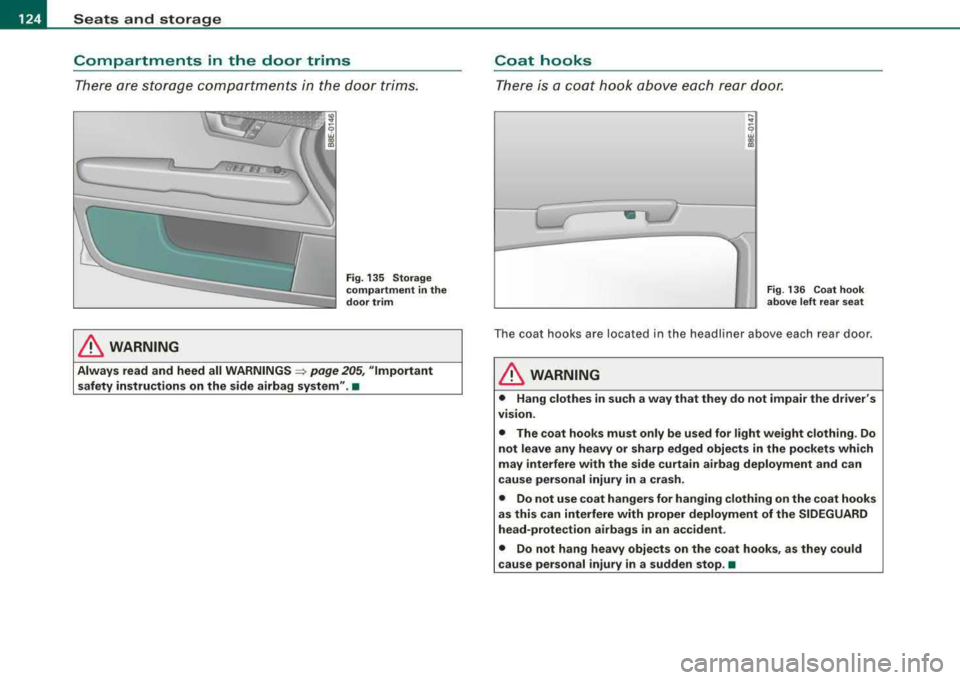
___ S_ e_ a_t _s _a_ n_d _ s_t _o _ r_ a...: g==-- e ______________________________________________ _
Compartments in the door trims
There are storage compar tments in the door trims.
& WARNING
Fig . 135 Storage
compartment in the
door trim
Always read and heed all WARNINGS => page 205 , "Important
safety instructions on the side airbag system ".•
Coat hooks
There is a coat hook above each rear door.
-~ -
---~ ----,-
-'
-
...
" ~ 9
13
-- ~
Fig . 136 Coat hook
above left rear seat
The coat hooks are locate d in the headlin er a bove each rear door .
& WARNING
• Hang clothes in such a way that they do not impair the driver 's
vision .
• The coat hooks must only be used for light weight clothing . Do
not leave any heavy or sharp edged objects in the pockets which
may interfere with the side curtain airbag deployment and can
cause personal injury in a crash .
• Do not use coat hangers for hanging clothing on the coat hooks
as this can interfere with proper deployment of the SIDEGUARD
head-protection airbags in an accident .
• Do not hang heavy objects on the coat hooks , as they could
cause personal injury in a sudden stop. •
Page 261 of 368
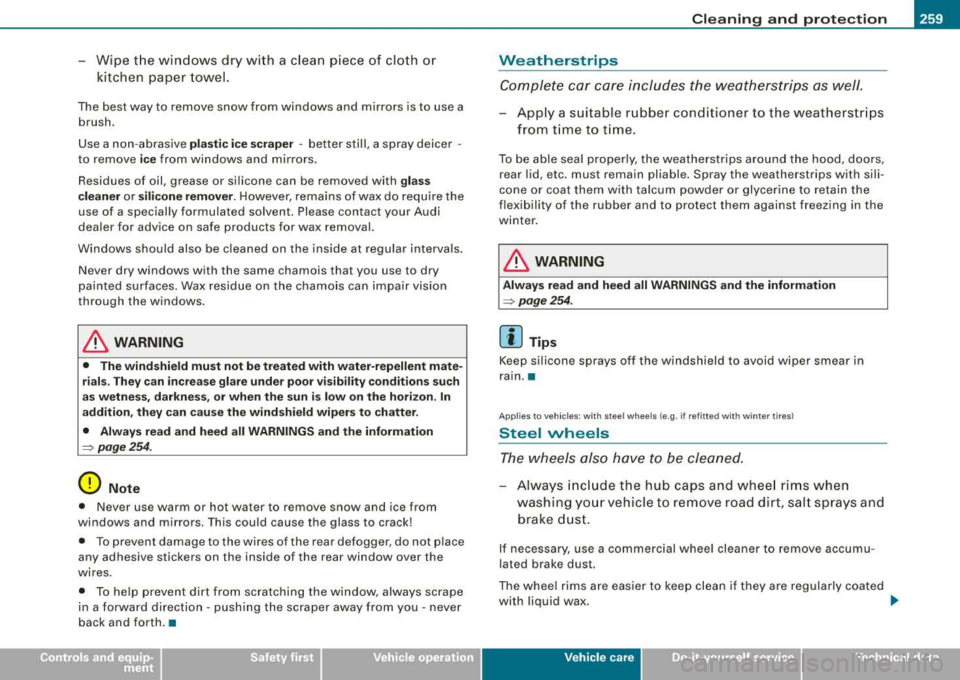
_____________________________________________ C_ l_ e _a_ n_ in~ g_a
_ n_d_ p_ r_ o_ t
_ e_ c_t _io _ n __ ffllll
-Wipe the windows dry with a clean piece of cloth or
kitchen paper towel.
The best way to remove snow from windows and mirrors is to use a
brush.
Use a non -abrasive
plastic ice scraper -better still, a spray deicer -
to remove
ice from windows and mirrors.
Residues of oil, grease or silicon e can be removed with
glass
cleaner
or silicone remover. However, remains of wax do require the
use of a specially formulated solvent. Please contact your Audi
dealer for advice on safe products for wax removal.
Windows should also be cleaned on the inside at regular intervals.
Never dry windows with the same chamois that you use to dry
painted surfaces. Wax residue on the chamois can impair vision
through the windows .
& WARNING
• The windshield must not be treated with water-repellent mate
rials. They can increase glare under poor visibility conditions such
as wetness, darkness, or when the sun is low on the horizon. In
addition, they can cause the windshield wipers to chatter.
• Always read and heed all WARNINGS and the information
=> page 254.
0 Note
• Never use warm or hot water to remove snow and ice from
windows and mirrors. This could cause the glass to crack!
• To prevent damage to the wires of the rear defogger, do not place
any adhesive stickers on the inside of the rear window over the
wires.
• To help prevent dirt from scratching the window, always scrape
in a forward direction -pushing the scraper away from you -never
back and forth .•
Weatherstrips
Complete car care includes the weatherstrips as well.
-Apply a suitable rubber conditioner to the weatherstrips
from time to time.
To be able seal properly, the weatherstrips around the hood, doors,
rear lid, etc . must remain pliable. Spray the weatherstrips with sili
cone or coat them with talcum powder or glycerine to retain the
flexibility of the rubber and to protect them against freezing in the
winter.
& WARNING
Always read and heed all WARNINGS and the information
=> page 254.
[ i ] Tips
Keep silicone sprays off the windshield to avoid wiper smear in
rain. •
Applies to veh ic les : with steel whee ls (e .g . if ref itted w ith wint er t ires )
Steel wheels
The wheels also have to be cleaned.
-Always include the hub caps and wheel rims when
washing your vehicle to remove road dirt, salt sprays and
brake dust.
If necessary, use a commercial wheel cleaner to remove accumu
lated brake dust.
The wheel rims are easier to keep clean if they are regularly coated
with liquid wax .
.,_
Vehicle care
Page 262 of 368
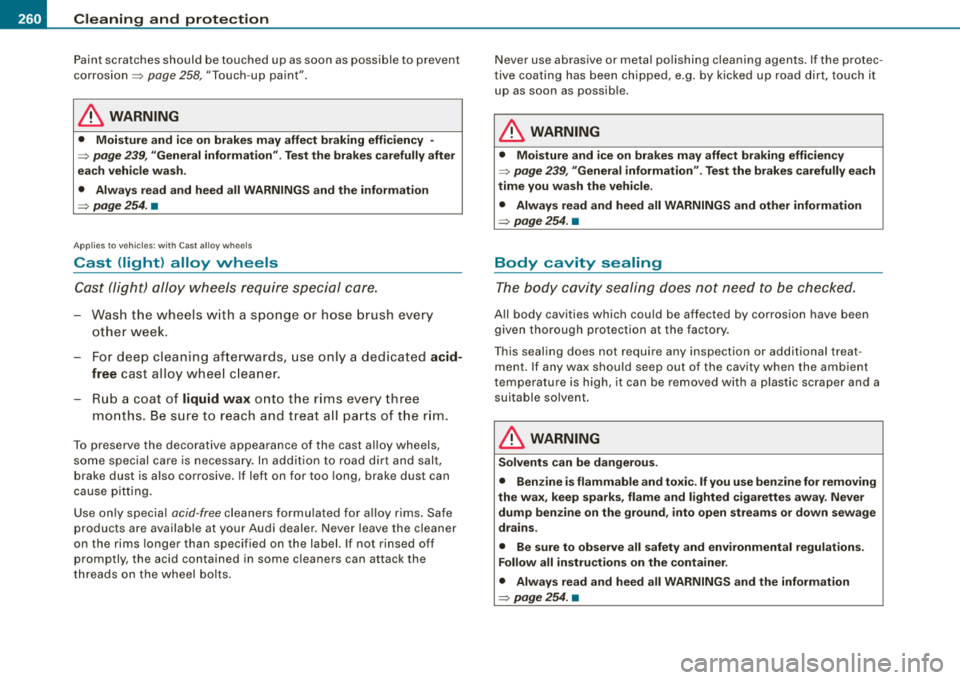
___ C_ le_a_ n_in ~ g_ a_n _ d_ p_ ro_ t_e _c _t _io _ n ___________________________________________ _
Paint scratches should be touched up as soon as possible to prevent
corrosion=> page 258, "Touch-up pain t" .
& WARNING
• Moisture and i ce on brake s may affect braking effic iency -
=> page 239, "General inform ation ". Test th e brakes care full y after
each vehicle wa sh.
• Always read a nd heed all WARNINGS and the information
=> page 254. •
A pplies to veh icl es : w ith Cas t alloy whee ls
Cast (light) alloy wheels
C ast (light) alloy wheels require special care .
-Wash the wheels with a spo nge or hose brush every
o th er week .
-For deep cleaning afte rwards, use only a dedicated acid
free cast a lloy whee l c leane r.
-Rub a coat of liquid wa x onto the r ims every three
months . Be sure to reach and t reat a ll pa rts of the r im .
To preserve the decorative appearance of the cast alloy wheels,
some special care is necessary. I n addit ion to road d irt and salt,
brake dust is also corrosive . If left on for too long, brake dust can
cause pitting.
Use on ly specia l
acid-free cleaners formu lated for a lloy rims . Safe
products are availab le at your Audi dealer. Never leave the cleaner
on the rims longer than spec ified on the label. If not rinsed off
promptly, the acid contained in some cleaners can attack the
threads on the wheel bo lts. Never use abrasive or metal po
lishing cleaning agents . If the protec
t ive coat ing has been chipped, e.g . by kicked up road d irt, touch i t
up as soon as possib le .
& WARNING
• Moisture and i ce on bra kes m ay affect braking efficien cy
=> page 2 39 , "General information ". Test the brake s carefully each
time you wash the vehicle .
• Alwa ys read and heed all WARNINGS and other information
=> page 254 . •
Body cavity sealing
The body c avity se aling does n ot need to be c hecke d.
All body cavities which could be affected by corrosion have been
given thor ough protecti on a t the fac tory.
This sealing does not require any inspection or additional treat ment . If any wax should seep ou t of the cav ity w hen the a mbie n t
temperature is high, it can be removed with a p last ic scraper and a
suitable solvent .
& WARNING
Solvents can be dangerous .
• Ben zine i s flammable and to xic. If you use benzine for removing
the wax, keep sparks , flame and lighted cigarettes away . Never
dump benz ine on the ground , into open streams or do wn sewage
dr ains .
• Be sure to ob serve all safet y and env ironmental r egulat ions .
Follow all instru ctions on the container.
• Always read and heed all WARNINGS and the information
=> page 254 . •
Page 295 of 368
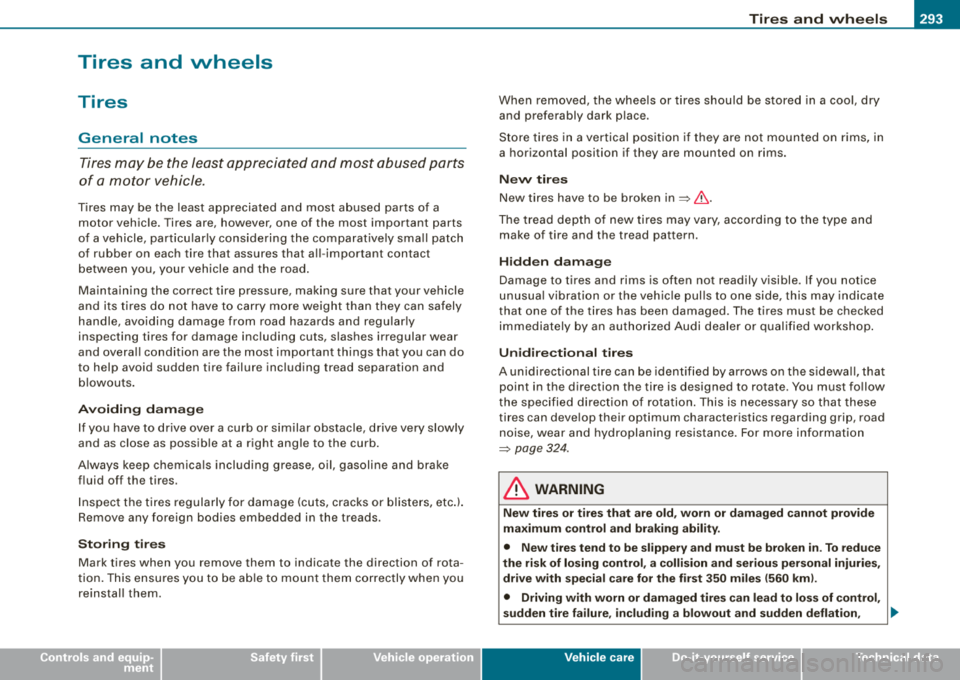
________________________________________________ T_ i
_ r_e _s_ a_n_ d_ w_ h_ e_e _ l_s __ lllll
Tires and wheels
Tires
General notes
Tires may be the least appreciated and most abused parts
of a motor vehicle.
T ires may be the least appreciated and most abused parts of a
motor vehic le. Tires are, however, one of the most important parts
of a vehicle, particu lar ly considering the comparat ive ly sma ll patch
of rubber on each tire that assures that a ll-important contact
between you, your vehicle and the road .
Maintaining the correct tire pressure, making sure that your vehicle
and i ts tires do not have to carry more weight than they can safely
handle, avoiding damage from road hazards and regular ly
inspecting tires for damage inc luding cuts, s lashes irregular wear
and overa ll condition are the most important things that you can do
to help avoid sudden tire failure including tread separation and
b lowou ts .
Av oiding d am ag e
If you have to drive over a curb or similar obstacle, drive very slowly
and as close as possible at a right angle to the curb.
A lways keep chemica ls including grease, o il, gasoline a nd brake
fluid off the tires.
I nspect the t ires regularly for damage (cuts, cracks or blisters, etc .l.
Remove any foreign bodies embedded in the treads.
Storing tire s
Mark tires when you remove them to indicate the direction of rota
t ion . This ensu res you to be ab le to mou nt them correctly w he n you
reinstal l them. When removed, the whee
ls or tires should be stored in a coo l, dry
and preferably dark place.
St ore tires in a vertical posit ion i f th ey are not mounted on r ims, in
a horizontal position if they are mounted on rims.
New tire s
New tires have to be broken in => &.
The tread dept h of new tires may vary, according to the type and
make of tire and the tread pattern .
Hidden damage
Damage to tires and rims is often not readily visible. If you notice
unusua l vibration or t he veh ic le pul ls to one side, this may indicate
that one of the tires has been damaged . The tires must be checked
immediately by an author ized Audi dealer or qualified workshop .
Unidire ction al tires
A unidirectio nal tire can be ide ntif ied by arr ows on the s idewa ll, t hat
point in the direction the tire is designed to rotate. You must fo llow
the specified direct ion of ro tation . This is necessary so t hat these
tires can deve lop their optimum characteristics regarding grip, road
noise, wear and hydroplaning resistance . For more info rmation
=> page 324.
& WARNING
Ne w tire s or tire s that are old , wo rn o r damaged cannot p ro vide
maximum control and braking abilit y.
• New tires tend to be slippery and mu st be brok en in . To redu ce
the ri sk of lo sing control , a c ollision and seriou s per sonal injuries ,
dri ve w ith special ca re for the fi rst 350 mile s (560 km l.
• Driving with worn or damaged tire s can lead to lo ss of control ,
sudden tire fa ilure , in cluding a blowout and sudden deflation ,
.,_
Vehicle care
Page 301 of 368
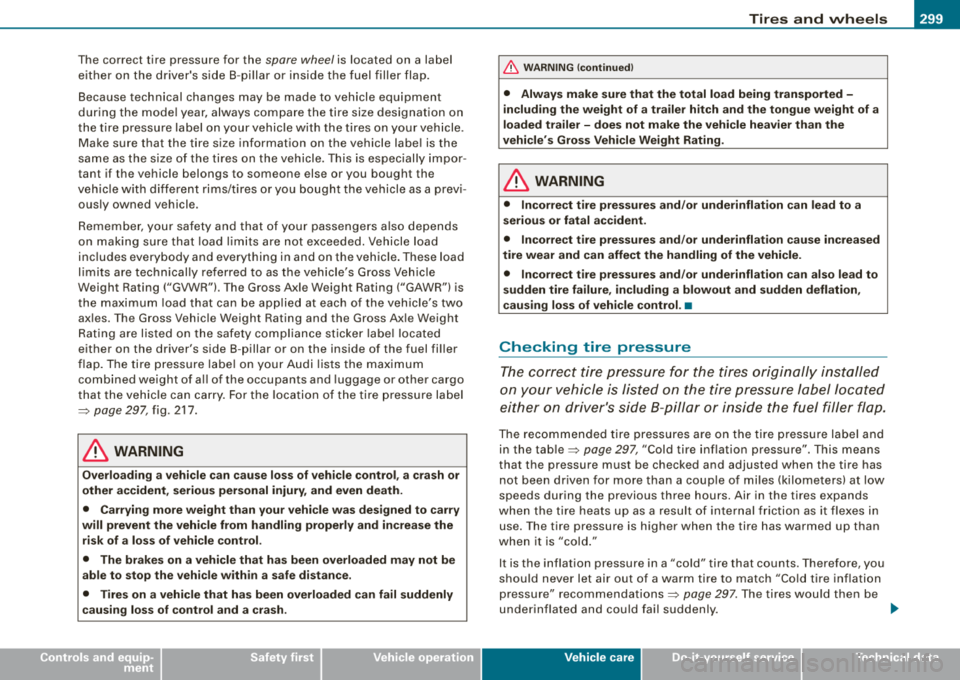
________________________________________________ T_ i
_ r_e _s_ a_n_ d_ w_ h_ e_e _ l_s __ fflll
The correct tire pressure for the spore wheel is located on a label
either on the driver's side B-pillar or inside the fuel filler flap.
Because technical changes may be made to vehicle equipment
during the model year, always compare the tire size designation on
the tire pressure label on your vehicle with the tires on your vehicle.
Make sure that the tire size information on the vehicle label is the
same as the size of the tires on the vehicle. This is especially impor
tant if the vehicle belongs to someone else or you bought the
vehicle with different rims/tires or you bought the vehicle as a previ
ously owned vehicle .
Remember, your safety and that of your passengers also depends
on making sure that load limits are not exceeded. Vehicle load
includes everybody and everything in and on the vehicle. These load
limits are technically referred to as the vehicle's Gross Vehicle
Weight Rating ("GVWR"l. The Gross Axle Weight Rating ("GAWR"l is
the maximum load that can be applied at each of the vehicle's two
axles. The Gross Vehicle Weight Rating and the Gross Axle Weight
Rating are listed on the safety compliance sticker label located
either on the driver's side B-pillar or on the inside of the fuel filler
flap. The tire pressure label on your Audi lists the maximum
combined weight of all of the occupants and luggage or other cargo
that the vehicle can carry. For the location of the tire pressure label
=> page 297, fig. 217.
& WARNING
Overloading a vehicle can cause loss of vehicle control, a crash or
other accident, serious personal injury, and even death.
• Carrying more weight than your vehicle was designed to carry
will prevent the vehicle from handling properly and increase the risk of a loss of vehicle control.
• The brakes on a vehicle that has been overloaded may not be
able to stop the vehicle within a safe distance.
• Tires on a vehicle that has been overloaded can fail suddenly
causing loss of control and a crash.
& WARNING (continued)
• Always make sure that the total load being transported -
including the weight of a trailer hitch and the tongue weight of a
loaded trailer -does not make the vehicle heavier than the
vehicle's Gross Vehicle Weight Rating.
& WARNING
• Incorrect tire pressures and/or underinflation can lead to a
serious or fatal accident.
• Incorrect tire pressures and/or underinflation cause increased
tire wear and can affect the handling of the vehicle.
• Incorrect tire pressures and/or underinflation can also lead to
sudden tire failure, including a blowout and sudden deflation,
causing loss of vehicle control. •
Checking tire pressure
The correct tire pressure for the tires originally installed
on your vehicle is listed on the tire pressure label located
either on driver's side B-pillar or inside the fuel filler flap.
The recommended tire pressures are on the tire pressure label and
in the
table=> page 297, "Cold tire inflation pressure". This means
that the pressure must be checked and adjusted when the tire has
not been driven for more than a couple of miles (kilometers) at low
speeds during the previous three hours. Air in the tires expands
when the tire heats up as a result of internal friction as it flexes in
use. The tire pressure is higher when the tire has warmed up than
when it is "cold."
It is the inflation pressure in a "cold" tire that counts. Therefore, you
should never let air out of a warm tire to match "Cold tire inflation
pressure"
recommendations=> page 297. The tires would then be
underinflated and could fail suddenly. .,._
Vehicle care
Page 307 of 368
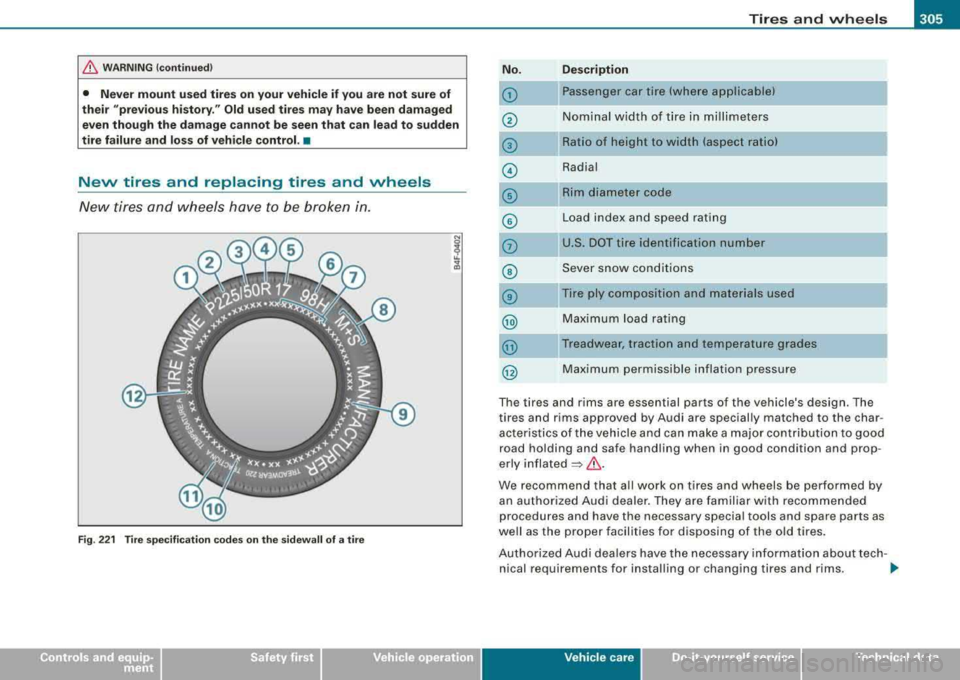
__________________________________________________ T_ ir_e _ s_ a_ n
_ d_ w_ h_ e_ e_ls _ __. 11111
/b, W ARNING (continued )
• Never mount u sed tires on your vehicle if you are not sure of
their "previou s history. " Old used ti res may ha ve been damaged
even though the damage cannot be seen that can lead to sudden
tire failu re and loss of vehicle control.
•
New tires and replacing tires and wheels
N ew tires and wheels have to be bro ken i n.
12
9
Fig . 22 1 Tire spe cificati on code s on the sidewall of a tire
No .
0
@
®
©
©
Description
Passenger car tire (where applicable)
Nominal w idth o f tire in mi llime ters
Ratio of height to width (aspect ratio)
Radia l
Rim diameter code
© Load index and speed rating
0
©
©
@)
1ju.s. DOT tire identification number
Sever snow cond itions
Tire ply composition and materials used
Max imu m load rating
@ Treadwear, traction and temperature grades
@ Maximum permissible inflation pressure
The t ires and rims are ess ential parts of the ve hicle's design . T h e
tires and rims approved by Audi are specially matched to the char
ac ter is ti cs of th e vehicle and can mak e a major contribution to good
road holding and safe hand ling when in good condition and prop
erly i nflated
=> /b, .
We recommend that a ll work on tires and wheels be perfo rmed by
an au thorized Audi dealer . They a re familia r with recommended
procedures and have the necessary specia l tools and spare parts as
we ll as the proper facilities fo r dispo sing of the o ld tires.
Authori zed Audi d ea lers have the n ecessa ry in for mati on abo ut tec h-
nical requirements for instal ling or changing tires and rims . _...
Vehic le care Technical data
Page 309 of 368
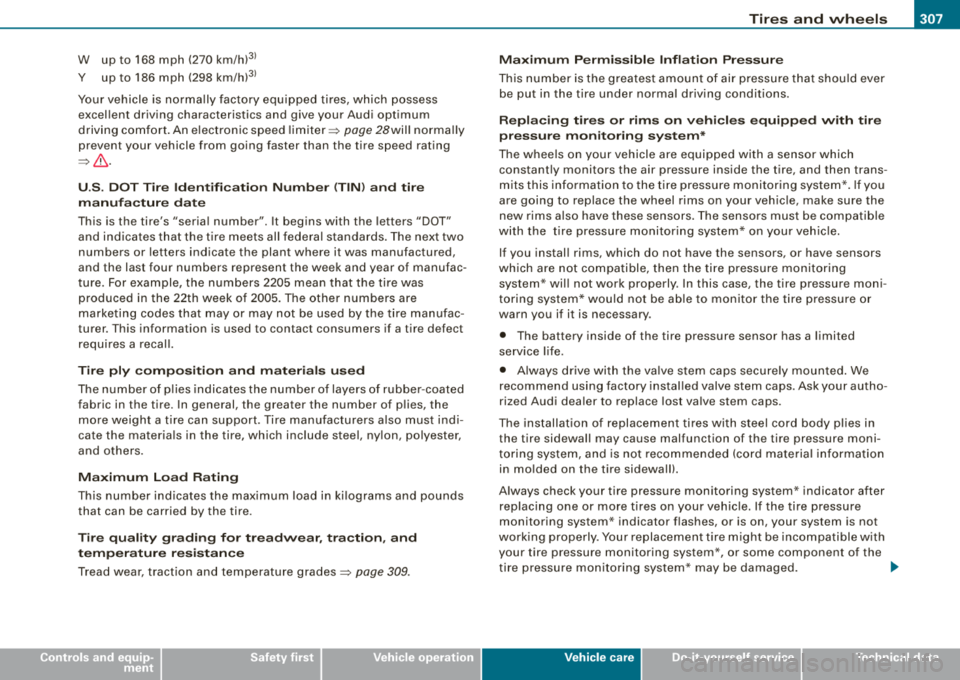
________________________________________________ T_ i
_ r_e _s_ a_n_ d_ w_ h_ e_e _ l_s __ l!III
W up to 168 mph (270 km/h)3
)
Y up to 186 mph (298 km/h)3
l
Your vehicle is normally factory equipped tires, which possess
excellent driving characteristics and give your Audi optimum
driving comfort. An electronic speed
limiter => page 28will normally
prevent your vehicle from going faster than the tire speed rating
=> & .
U .S. DOT Tire Identification Number (TIN) and tire
manufacture date
This is the tire's "serial number". It begins with the letters "DOT"
and indicates that the tire meets all federal standards. The next two
numbers or letters indicate the plant where it was manufactured,
and the last four numbers represent the week and year of manufac
ture . For example, the numbers 2205 mean that the tire was
produced in the 22th week of 2005. The other numbers are
marketing codes that may or may not be used by the tire manufac
turer. This information is used to contact consumers if a tire defect
requires a recall.
Tire ply composition and materials used
The number of plies indicates the number of layers of rubber-coated
fabric in the tire. In general, the greater the number of plies, the
more weight a tire can support. Tire manufacturers also must indi
cate the materials in the tire, which include steel, nylon, polyester,
and others.
Maximum Load Rating
This number indicates the maximum load in kilograms and pounds
that can be carried by the tire.
Tire quality grading for treadwear, traction, and
temperature resistance
Tread wear, traction and temperature grades=> page 309 . Maximum Permissible Inflation Pressure
This number is
the greatest amount of air pressure that should ever
be put in the tire under normal driving conditions.
Replacing tires or rims on vehicles equipped with tire
pressure monitoring system*
The wheels on your vehicle are equipped with a sensor which
constantly monitors the air pressure inside the tire, and then trans
mits this information to the tire pressure monitoring system*. If you
are going to replace the wheel rims on your vehicle, make sure the
new rims also have these sensors. The sensors must be compatible
with the tire pressure monitoring system* on your vehicle.
If you install rims, which do not have the sensors, or have sensors
which are not compatible, then the tire pressure monitoring
system * will not work properly. In this case, the tire pressure moni
toring system* would not be able to monitor the tire pressure or
warn you if it is necessary .
• The battery inside of the tire pressure sensor has a limited
service life.
• Always drive with the valve stem caps securely mounted. We
recommend using factory installed valve stem caps . Ask your autho
rized Audi dealer to replace lost valve stem caps.
The installation of replacement tires with steel cord body plies in
the tire sidewall may cause malfunction of the tire pressure moni
toring system, and is not recommended (cord material information
in molded on the tire sidewall).
Always check your tire pressure monitoring system* indicator after
replacing one or more tires on your vehicle. If the tire pressure
monitoring system * indicator flashes, or is on, your system is not
working properly. Your replacement tire might be incompatible with
your tire pressure monitoring system*, or some component of the
tire pressure monitoring system* may be damaged.
....
Vehicle care
Page 310 of 368
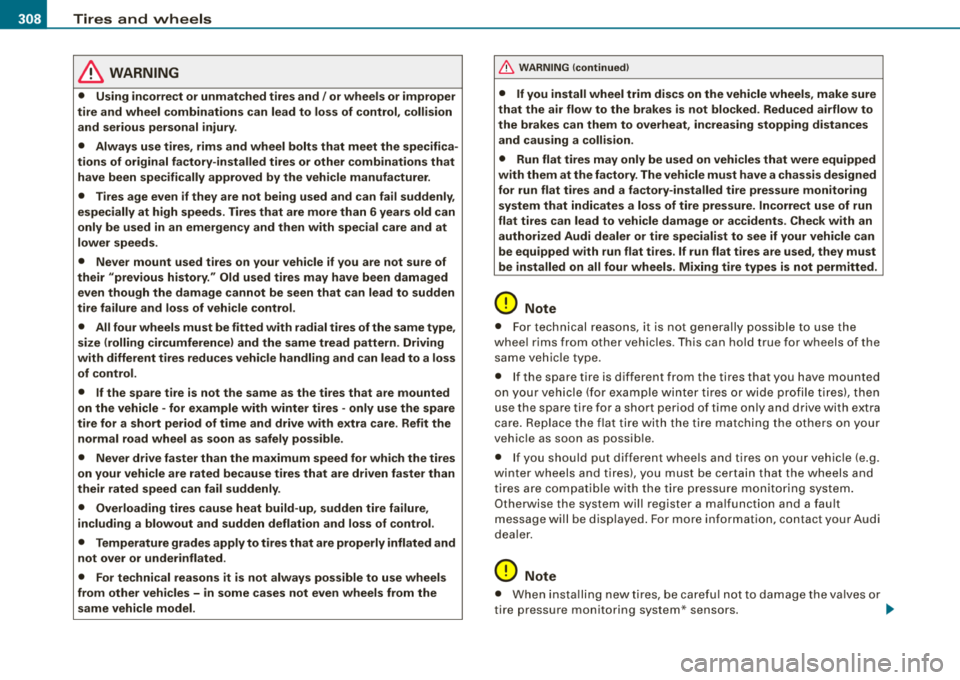
___ T_ ir_e _ s_ a_ n
_ d_ w_ h_ e_ e_ls _________________________________________________ _
& WARNING
• Using incorrect or unmatched tires and / or wheels or improper
tire and wheel combinations can lead to loss of control , collision
and serious personal injury .
• Always u se tires , rims and wheel bolts that meet the specifica
tions of original factory -installed tires or other combinations that
have been specifically approved by the vehicle manufacturer.
• Tires age even if they are not being used and can fail suddenly ,
especially at high speeds . Tires that are more than 6 years old can
only be used in an emergen cy and then with special care and at
lower speed s.
• Never mount used tires on your vehi cle if you are not sure of
their "previous history." Old used tires may have been damaged
even though the damage cannot be seen that can lead to sudden
tire failure and loss of vehicle control.
• All four wheels must be fitted with radial tires of the same type ,
size (rolling circumference ) and the same tread pattern. Driving
with different tires reduces vehi cle handling and can lead to a loss
of control.
• If the spare t ire is not the same as the tires that are mounted
on the vehicle -for example with winter tires -only use the spare
tire for a short period of time and drive with extra care . Refit the
normal road wheel as soon as safely possible.
• Never drive faster than the ma ximum speed for wh ich the tires
on your vehicle are rated because tires that are driven faster than
their rated speed can fail suddenly .
• Overloading tire s cause heat build -up , sudden tire failure ,
including a blowout and sudden deflation and loss of control.
• Temperature grades apply to tires that are properly inflated and
not over or underinflated .
• For technical reasons it is not always possible to use wheel s
from other vehicles - in some cases not even wheels from the
same vehicle model.
& WARNING (continued )
• If you install wheel trim discs on the vehicle wheels, make sure
that the air flow to the brakes is not blocked . Reduced airflow to
the brakes can them to overheat , increasing stopping distances
and causing a collision .
• Run flat tires may only be used on vehicles that were equipped
with them at the factory. The vehicle must have a chassis designed
for run flat tires and a factory-installed tire pressure monitoring
s ystem that indicate s a loss of tire pressure . Incorrect use of run
flat tires can lead to vehicle damage or ac cidents . Check with an
authorized Audi dealer or tire specialist to see if your vehicle can
be equ ipped with run flat tires . If run flat tires are used , they must
be installed on all four wheels . Mixing tire types is not permitted.
0 Note
• For tec hnical r eas ons, it is no t gene rally possible to use the
whee l rims from other vehicles . ihis can hold true for wheels of the
same ve hicle type.
• I f the spare tire is different from the tires that you have mounted
on y our ve hicle (f or exampl e wi nter t ires or wide p ro fi le tir es), then
use the spa re tire fo r a short per iod of time on ly and d rive with extra
c a re . Rep lace the flat t ire wi th the ti re m atc h ing t he oth ers o n you r
vehic le as soon as possib le .
• If yo u should put diff eren t w heels a nd tires on yo ur vehi cle (e. g.
winter wheels and tires), you must be certa in that the wheels and
t ires a re co mpatibl e w ith the tire press ur e m onit orin g sys te m.
Otherwise the system will regist er a ma lfunction and a fau lt
mes sage wil l be d isp layed . Fo r mo re info rmation, contact yo ur Audi
dea ler .
0 Note
• When i nsta lling new ti res, be care fu l n ot to damage t he va lves o r
tire press ure mon itoring system* sensors . .,_
Page 313 of 368
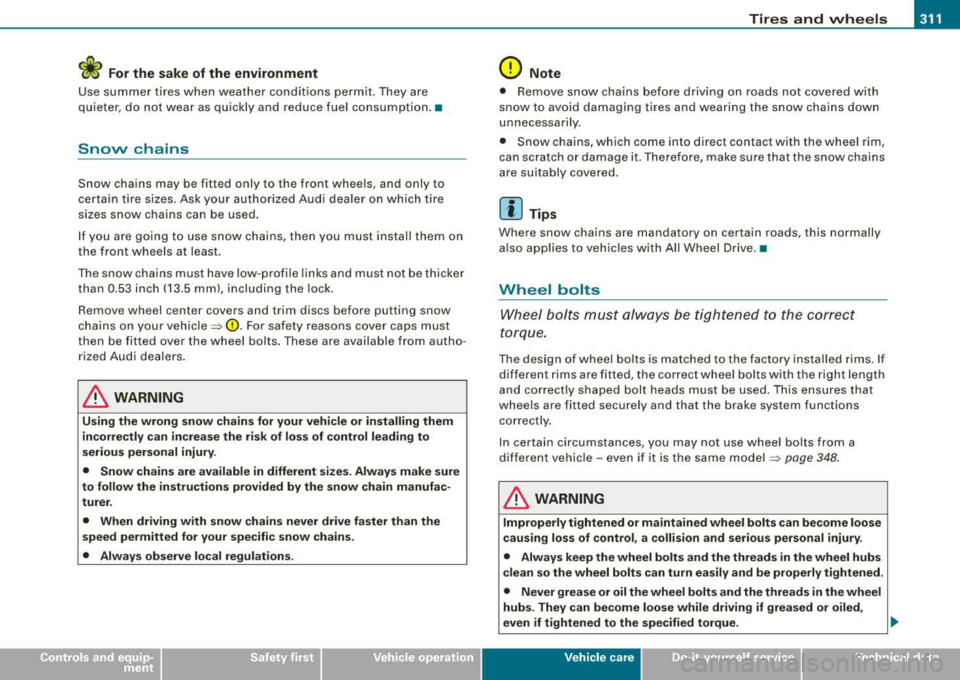
Tires and wheels 1111
----------------
W For the sake of the environment
Use summer tires when weather conditions permit. They are
quieter, do not wear as quickly and reduce fuel consumption. •
Snow chains
Snow chains may be fitted only to the front wheels, and only to
certain tire sizes. Ask your authorized Audi dealer on which tire
sizes snow chains can be used.
If you are going to use snow chains, then you must install them on
the front wheels at least.
The snow chains must have low-profile links and must not be thicker
than 0.53 inch (13.5 mm), including the lock.
Remove wheel center covers and trim discs before putting snow
chains on your
vehicle => 0. For safety reasons cover caps must
then be fitted over the wheel bolts. These are available from autho
rized Audi dealers.
& WARNING
Using the wrong snow chains for your vehicle or installing them
incorrectly can increase the risk of loss of control leading to
serious personal injury.
• Snow chains are available in different sizes. Always make sure
to follow the instructions provided by the snow chain manufac
turer.
• When driving with snow chains never drive faster than the
speed permitted for your specific snow chains.
• Always observe local regulations .
0 Note
• Remove snow chains before driving on roads not covered with
snow to avoid damaging tires and wearing the snow chains down
u n necessarily.
• Snow chains, which come into direct contact with the wheel rim,
can scratch or damage it . Therefore, make sure that the snow chains
are suitably covered.
[ i] Tips
Where snow chains are mandatory on certain roads, this normally
also applies to vehicles with All Wheel Drive. •
Wheel bolts
Wheel bolts must always be tightened to the correct
torque.
The design of wheel bolts is matched to the factory installed rims. If
different rims are fitted, the correct wheel bolts with the right length
and correctly shaped bolt heads must be used. This ensures that
wheels are fitted securely and that the brake system functions
correctly.
In certain circumstances, you may not use wheel bolts from a
different vehicle -even if it is the same
model => page 348.
& WARNING
Improperly tightened or maintained wheel bolts can become loose
causing loss of control, a collision and serious personal injury.
• Always keep the wheel bolts and the threads in the wheel hubs
clean so the wheel bolts can turn easily and be properly tightened .
• Never grease or oil the wheel bolts and the threads in the wheel
hubs. They can become loose while driving if greased or oiled,
even if tightened to the specified torque.
.,_
Vehicle care